This is a story about something that is right in this world. It’s a story of inspiration and real world solutions, a down to earth celebration of the most basic yet profound connection we have to the planet that sustains us — its soil and crops. It’s also a simple appeal for support of a transformational project that combines human ingenuity, ecological healing, and more widespread and equitable access to life-enhancing nutrients for everyone.
Farmer and MacArthur Fellowship recipient Will Allen has been a giant in the urban farming and food justice movement for years. His organization Growing Power is currently celebrating its 20th anniversary of connecting inner city residents with the land they live on, developing community farms and food centers that provide access to high-quality, safe, healthy, affordable food for everyone.
One of the biggest challenges of growing enough healthy local food in dense urban areas is to secure enough acreage to run a viable farm, so Growing Power’s most recent endeavor is the realization of a state of the art, 5-story Vertical Farm in the middle of Milwaukee. Their design was recently nominated as a finalist out of entries from 100 countries in the Architecture & Farming category of the Architizer A+ Awards.

The five-story Vertical Farm will expand Growing Powers greenhouse and aquaponics operations currently spread over a two-acre site in the City of Milwaukee. Image courtesy Kubala Washatko Architects
To win the Popular Choice for this literally groundbreaking design, the project needs YOUR vote by March 8th. Let’s help Growing Power’s vertical farm become a reality.
If the following description of the vertical farm doesn’t convince you, please follow me below the fold to learn more about Will Allen and his vision to grow healthy food, people, and communities.
Imagine a five-story farm in the middle of a city! This innovative design developed by The Kubala Washatko Architects, Inc. will expand Growing Power’s greenhouse and aquaponics operations currently spread over a two-acre site in the City of Milwaukee. Five stories of south-facing greenhouse areas allow production of plants, vegetables, and herbs year-round. Educational classrooms, conference spaces, demonstration kitchen, food processing and storage, freezers, and loading docks further support Growing Power’s mission as a local and national resource for sustainable urban food production.
Cast-in-place tilt-up concrete panel construction provides an affordable, energy efficient, structurally stable, and long-lasting building shell appropriate for intensive farming operations.
Energy and water flows throughout the building are carefully designed. The building absorbs sunlight and takes advantage of solar convective currents. Heat generated by the sun is stored via underground thermal mass and used to warm the building in winter. Roof-mounted photovoltaic panels and thermal solar panels generate a portion of building energy needs. Use of natural daylight reduces energy use. A closed loop of water and nutrients circulates throughout the building; fish wastes are used as food for plants, while plants clean and filter the water for fish. Rainwater falling on the building is collected and stored to support the system.
The Vertical Farm expands and improves year-round retail space selling fresh, nutritious, and affordable food. The Vertical Farm also creates an active outdoor market area that will become a community gathering place for work, learning, and social activities.
Growing Power Urban Farm. Image courtesy Kubala Washatko Architects.
I first heard of Will Allen when Ecocity Builders, the non-profit I’m advising for was collaborating with an African American community in the Village Bottoms neighborhood of West Oakland to draw up a plan for a sustainable cultural district. While we were drafting the larger ecocity blueprint for the district, community members were eager to get going on shovel-ready projects, and the Village Bottoms Farm on a former industrial lot was the perfect place to start.
There was one problem, of course. As with so many industrial sites in cities across the U.S. that are spread across low-income neighborhoods, the soil was so contaminated with heavy metals and chemicals that you wouldn’t want to grow food in it. The good news was that Will Allen had encountered the exact same problem when he first started a farm stand not far from Milwaukee’s largest public housing project, and in the decade since not only figured out ways to overcome this obstacle but made it his mission to teach other communities to do the same.
After a trip to Milwaukee to attend several workshops with Allen, the Village Bottoms delegation returned with the skills and knowledge they needed to get their own farm going. They built and scraped together the raised beds they needed, nourishing their own healthy soil with food waste compost…
They learned about vermicompost, using red wiggler worms to create a nutrient-rich, organic fertilizer and soil conditioner…
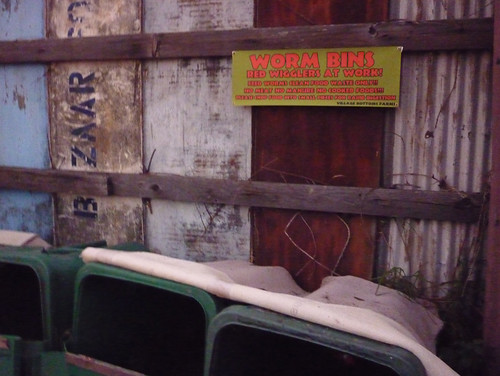
The most ambitious project the Bottoms farmers were also the most excited about was the aquaponics tank. Aquaponics is a method of growing crops and fish together in a re-circulating system, and in the Growing Power aquaponics model crops grow vertically on raised beds.
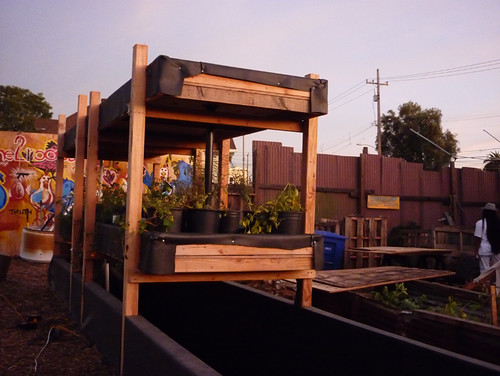
The MacArthur “Genius Award” winner describing the Growing Power model in his own words…
You get the idea. Will Allen is not about lofty talk or abstract concepts about how we might some day save the planet, but about hands in the dirt, back to basics urban reconnection with the turf we walk on, empowering us all to not only raise up beds of vegetables but ourselves and our communities.
In his recently published book, The Good Food Revolution, Will writes:
Children often come into my facility for the first time with their pockets filled with candy, acting wild. Something changes in them when they walk up to my worm systems and put their hands in the soil for the first time. They mellow. It can be a spiritual thing simply to touch the earth if you have been disconnected from it for so long.

The Good Food Revolution is a highly recommended read. It chronicles the son of a sharecropper who never dreamed of becoming a farmer himself but is reconnected with his farm roots during a stint as a professional basketball player in Belgium. It’s not until he’s back in the United States working as a salesman for Kentucky Fried Chicken and Procter & Gamble when he discovers the two-acre plot in the middle of an urban food desert and cashes in his retirement fund to start his own farm stand.
The book is filled with moving personal stories of hardship, perseverance and transcendence, about Allen himself but even more so about the inner city youth who find their footing through the work and community on this little plot. It is a tribute to the author’s authentic humility and earthy grace that he places just as much importance on the small personal victories of one of his employees’ son as he does on a collaboration with First Lady Michelle Obama, who is eager to learn from the Growing Power model in her fight against childhood obesity and food insecurity.
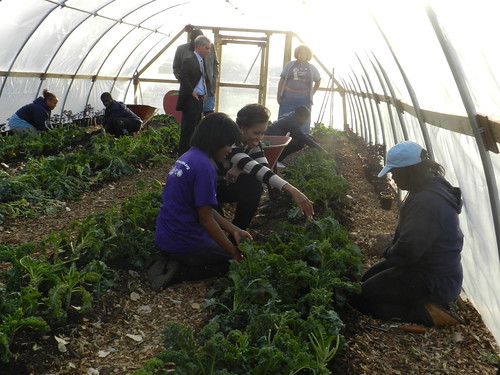
First Lady Michelle Obama getting her hands dirty, learning about healthy and sustainably grown food in urban environments. Photo courtesy Growing Power
I had the pleasure of meeting Will during his book tour last summer, and that was when I first heard about his plans for the Vertical Farm. You could tell how excited he was about the project as he was talking about it. I sneaked in for a snapshot as I could sense that this was something truly monumental he was unveiling…

What’s so brilliant and beautiful about this vertical farm is that it is truly integrative, addressing a whole range of overlapping areas that are pivotal to any kind of meaningful long-term solutions to our planetary ailments. From food security to community outreach, from sustainable development to equal access, from green building design to high density land use, the vertical farm is a natural fit for the compact ecological cities we need to build and design if we want to get serious about dealing with the roots of climate change and a whole host of other environmental, energy and social problems.
So take it in one more time, and don’t forget to VOTE by March 8th.

Growing Power Urban Farm. Image courtesy Kubala Washatko Architects.
Yours truly,
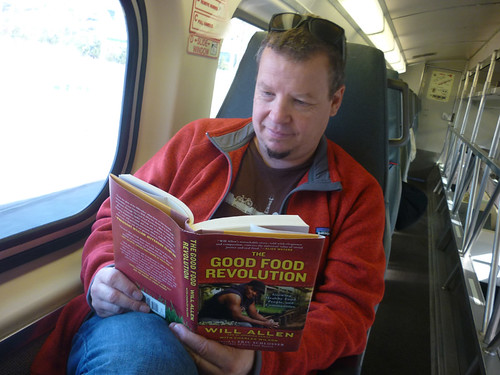


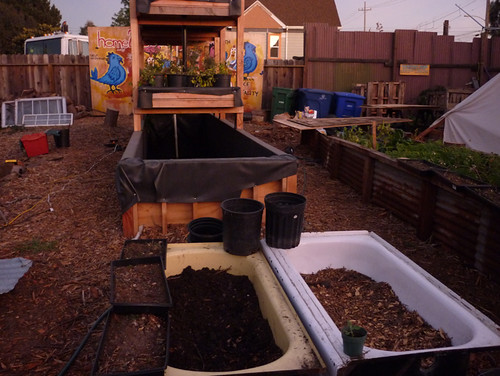






The one problem with this otherwise wonderful vision is that Will Allen has been using PVC pipe in his aquaculture systems. There is a wealth of data available about the consequences of using PVC, particularly about the toxic organotin compounds that leach out of PVC and accumulate in fish. Other materials are available, however his use of PVC has encouraged other aquaculture developers to use it as well. This is very troubling. Please look into this yourself. Check what the EPA says about PVC, what Canada has mandated re. PVC, how organotin compounds have contaminated world fisheries, etc.
Thanks for the info, Todd. I’ll definitely look into it. Do you know of any alternatives to PVC pipes that aquaponic farmers could use? I would think if there’s a reasonably priced healthier alternative material, Growing Power and others would be open to switching.
HDPE is much better. It costs a little more per lineal foot and requires a special tool to join, however it has the additional advantage of being capable of bending (large radius). I tried to get Sweet Water Organics to use this instead of PVC, but because Will used PVC they went with PVC. I have also tried to get Growing Power to change to no avail.
The issue has been a bugaboo of the aquaponics community for years with many choosing to ignore it. If you research it you will find that it should not be ignored though.
There are large scale operations that do use HDPE because of this very concern.
If you need references re. PVC and organotin leachates let me know.
Todd, thanks for the heads-up on HDPE. I probably don’t have the time right now to go in deep pursuit of this subject, but it would be great to have some links to sources for when it comes up, so whatever you feel is worth your time and energy, feel free to drop it in another comment. And you never know who might stop by this post and pick up on it. Just out of curiosity, what’s Growing Power’s reason for not looking into HDPE? It would be good to be familiar with both sides of this discussion.
I love this urban planning concept. I’m a passionate urban gardener. Just started tilling under my winter overcropping last weekend and will be out again this next weekend preparing for the first plantings of greens. I’m lucky to have a southwest facing elevated sunny spot. It is very visible to the neighbors and I’ve become the go to guy for garden advice. I relish the role. Put up around 60 quarts of tomatoes last year and never have to buy any onions. Neighbors are always finding goodies on their front porches during harvest time. You’ve inspired me to post on my vegetable garden and flower gardens soon. I’m very proud of our miniature model of Butchart Gardens. They are my environmental refuge.
There has been a growing trend in our dense city neighborhood to convert city owned strips of land next to roads into neighborhood gardens. Productive, beautifying and community building it’s a win all the way around.
We’ve had some pretty crappy news on the environmental front lately (record CO2, State Dept KXL environment assessment). Thanks for this positive news.
The above comments from Tod are very interesting. There a lot of irrigation systems around here with PVC pipes.
John, I had no idea you were a gardener! Sounds like a luscious plot you’re nursing, and I love the idea of an abundance of veggies to spread among your neighbors. There’s one video I saw of Will (not sure if it’s the one in my post) where he scoffs at the idea of putting up a fence around his plot. He basically says if people are stealing your food or trashing your farm then you need to do a better job of engaging with your community. Amen to that, it goes to the heart of our whole punitive revenge mind-set that has done so much damage in so many ways. I think food can be one of the great equalizers, the idea of freely sharing the fruits of the soil as a way to connect people with each other rather than divide them is so powerful. It’s so ancient, the whole breaking bread thing, but the whole industrialized food system where every bite is measured in nickels and dimes has really driven us apart and alienated so many of us from our innate ability of and penchant for sharing substance and essence with each other. There’s a lot of power in food, and we have to keep finding ways to unleash it in communities around the country and the world.
As always, thanks for your thoughtful comment!
PVC for irrigation is not near as bad as when used in a re-circulating system that grows fish or other sea food.
The reasons behind using PVC are rather tangled. They have to do with the ease of obtaining PVC (that’s another issue regarding PVC manufacturer’s marketing prowess), adding onto initial, proof-of-concept work and a reticence to address the issue of growing food with toxic compounds in them. It is complicated and best addressed at the early stages of setting up a system. Here are some links.
http://www.sciencedirect.com/science/article/pii/S0025326X08000258
http://www.epa.gov/esd/pdf-ecb/432ecb98.pdf
http://previous.delicious.com/redirect?url=http%3A//www.theecologist.org/News/news_analysis/1191046/which_chemicals_are_making_us_fat.html
http://previous.delicious.com/redirect?url=http%3A//www.latest-science-articles.com/Engineering_Science/Investigation-on-Interaction-of-Organotin-Compounds-with-Different-Species-and-B-22379.html
http://chemicalwatch.com/7721/scientists-study-endocrine-disrupting-and-weight-gain-effects-of-tbt
http://www.nmfs.noaa.gov/aquaculture/doc_policy/index.htm#vcomments
http://www.healthybuilding.net/pvc/pipes_report.pdf
http://ntp.niehs.nih.gov/ntp/htdocs/Chem_Background/ExSumPdf/Organotins.pdf
http://www.ncbi.nlm.nih.gov/pmc/?term=10.1289/ehp.8209
http://www.atsdr.cdc.gov/PHS/PHS.asp?id=541&tid=98
http://cfpub.epa.gov/si/si_public_record_Report.cfm?dirEntryId=220153
http://endo.endojournals.org/content/147/6/s50.full#R30
http://www.healthybuilding.net/pvc/Thornton_Enviro_Impacts_of_PVC.pdf
http://www.nytimes.com/2009/06/28/opinion/28kristof.html?_r=0
http://cfpub.epa.gov/ordpubs/nerlpubs/recordisplay.cfm?deid=62513
https://groups.google.com/forum/?hl=en&fromgroups=#!topic/urban-aquaculture-conversations/wxHvxVK-8qo
OK, I think you get the idea. Some of the material above is a little less accessible to the layman, however the abstracts are clear and easy to understand.
Thank you so much, Todd. Great reference material. I’ll check it out and refer folks when the subject comes up.
Thanks Sven! I think that projects like vertical farming are very important, but if not done right could lead to more harm being done than good. I think positive critiques of projects like this are essential.
I hope to comment at length soon, but wanted to say thank you for letting us know how to vote – I just regret I didn’t read your post until today! Will spread the word…
Thanks Naima. The vote was kinda last minute and the vertical farm was trailing a couple of other projects by pretty large margins, but I know there’s also a juried vote in addition to people’s choice. I sometimes feel the internet clicks favor those with the largest social network, so i’m hoping the vertical farm will still get the kind of recognition it deserves.
Working the kinks out is part of the process, but this is certainly an impressive project. I am heartened by how much urban, sustainable gardening is being tried.
Yes, I see and read about urban gardens popping up everywhere. I think it’s one of those things that could truly be considered silver bullets, dealing with a multitude of issues like public health, sustainable cities, soil restoration, food systems, CO2 emissions, social justice, etc. I wonder if it would be possible to have little plots in your neck of the woods, Al. Kind of like these little plots I saw last year along the Limmat River in Zürich, Switzerland…
I’m seeing a resurgence here with the family garden and support of food co-ops that are providing patronage for small family farms typically regarded as being too small to be competitive against big agribusiness. There is also a rising sense that one of the best things you can do for yourself is learn how to grow food. More frequently now, you can hear the growing of urban roosters in my city.
[…] The Good Food Revolution Goes Vertical (svenworld.com) […]
Sven, You love Will Allen because he’s down to earth and straight-talking. You are the same way and combined with your thoughtful writing, you too are making a difference for our dear Mother Earth. Thank you for this inspiring story.
Thanks for the kind words, Pam. I’m not quite as literally down to earth as Will, but I try to keep digging as deeply as I can with my writing. Will’s grace, determination and humility is definitely worth aspiring to.